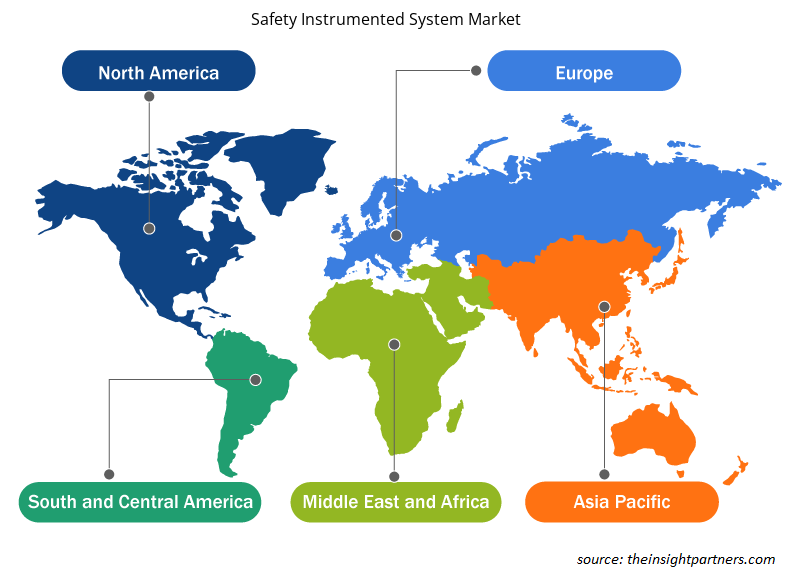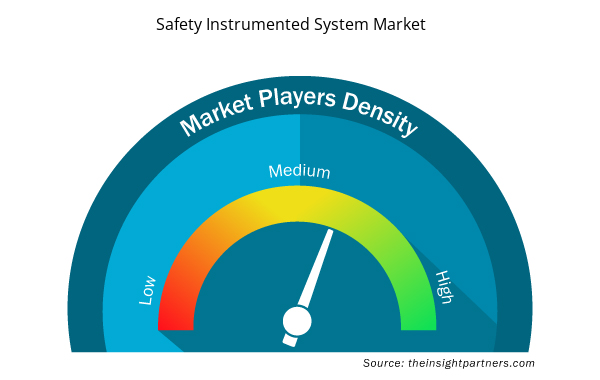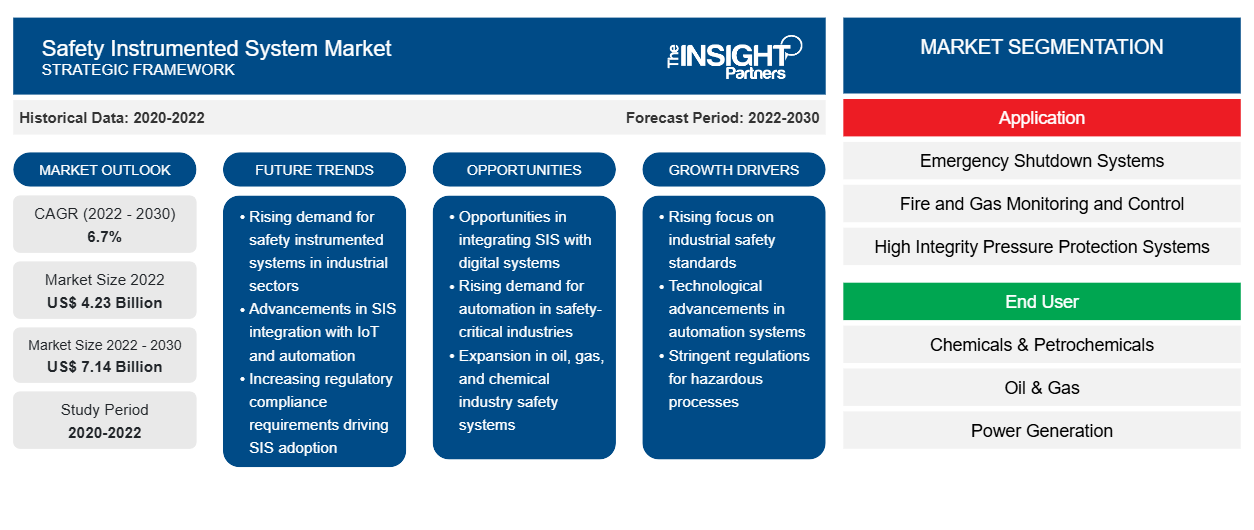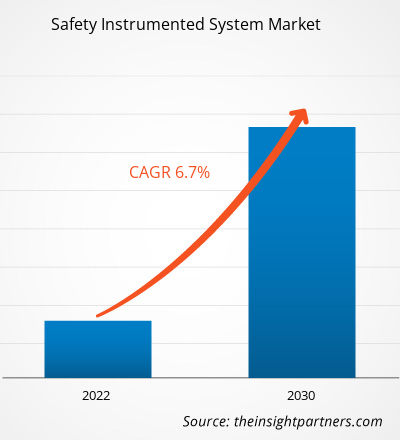[Rapport de recherche] Le marché des systèmes instrumentés de sécurité devrait passer de 4,23 milliards de dollars américains en 2022 à 7,14 milliards de dollars américains d'ici 2030 ; il devrait enregistrer un TCAC de 6,7 % de 2022 à 2030.
Point de vue de l'analyste :
La construction de nouvelles raffineries de pétrole et de gaz et la croissance des activités minières dans le monde entier sont les principaux facteurs qui alimentent la croissance du marché des systèmes instrumentés de sécurité. En outre, l'adoption croissante de réglementations et de normes de sécurité stimule la croissance du marché des systèmes instrumentés de sécurité. De plus, l'automatisation industrielle croissante dans l'industrie chimique et pétrochimique pour accroître l'efficacité et la sécurité des employés crée de nouvelles opportunités pour la croissance du marché des systèmes instrumentés de sécurité. La sensibilisation croissante à la sécurité dans différentes industries accélère encore l'expansion du marché des systèmes instrumentés de sécurité.
Aperçu du marché :
Un système instrumenté de sécurité (SIS) est utilisé dans de nombreuses usines de traitement car il permet de prendre des mesures automatisées pour maintenir une usine dans un état sûr lorsque des conditions anormales surviennent. En cas de perturbation pouvant entraîner un incident malheureux, le SIS ramènera automatiquement le processus dans un état sûr et contribuera à prévenir les pertes humaines, les dommages matériels et les dommages environnementaux. Plusieurs événements catastrophiques peuvent se produire sur différents sites opérationnels dans les industries pétrolière et gazière, chimique et autres qui utilisent des machines lourdes et des produits chimiques. Ces événements peuvent aller des incendies aux fuites pouvant entraîner des explosions, et le besoin de systèmes de sécurité haut de gamme tels que le SIS augmente dans le monde entier.
Personnalisez ce rapport en fonction de vos besoins
Vous bénéficierez d'une personnalisation gratuite de n'importe quel rapport, y compris de certaines parties de ce rapport, d'une analyse au niveau des pays, d'un pack de données Excel, ainsi que de superbes offres et réductions pour les start-ups et les universités.
- Obtenez les principales tendances clés du marché de ce rapport.Cet échantillon GRATUIT comprendra une analyse de données, allant des tendances du marché aux estimations et prévisions.
Moteur du marché :
L'expansion croissante de l'industrie pétrolière et gazière stimule la croissance du marché des systèmes instrumentés de sécurité
Les États-Unis sont l'un des plus grands producteurs de gaz naturel au monde. Selon l'Energy Information Administration (EIA) des États-Unis, le pays a produit environ 34 517 798 millions de pieds cubes (MMcf) de gaz naturel et consommé 30 664 951 MMcf de gaz naturel en 2021. Le pays a également exporté 3 560 818 MMcf de gaz naturel liquéfié (GNL). Divers nouveaux projets de construction de pétrole et de gaz sont également en cours dans le monde. Au deuxième trimestre 2022, les travaux de construction du projet Centre d'excellence pour le captage et l'élimination du carbone ont commencé à Burnaby, en Colombie-Britannique, au Canada. Ils comprenaient la construction d'une usine de CSC, qui permet de capturer et de stocker jusqu'à 2 000 tonnes métriques de CO2 par jour. De même, la construction du projet d'usine de gaz naturel liquéfié de Vista Pacifico a commencé au deuxième trimestre 2022, avec un investissement de 2 000 millions de dollars américains. Dans le cadre de ce projet, un terminal d'exportation de GNL sera construit sur 150 hectares dans la municipalité d'Ahome, Topolobampo, Sinaloa, Mexique. Ainsi, de tels projets de construction de pétrole et de gaz stimuleront la demande de systèmes instrumentés de sécurité.
En outre, selon le rapport Statistiques de l'industrie minière suédoise 2021, la production suédoise de minerai a atteint 88,6 millions de tonnes métriques en 2021, soit une augmentation de 22 % depuis 2015. De plus, selon le Bureau australien des statistiques, la production minière en Australie a augmenté de 5,7 % au premier trimestre 2023. Ainsi, la croissance de la production minière dans le monde devrait faire augmenter la demande de sécurité et de surveillance pour garantir la sécurité des employés, des équipements ou des matériaux. Ce besoin croissant de systèmes instrumentés de sécurité stimule encore davantage la croissance du marché des systèmes instrumentés de sécurité.
Segmentation et portée du rapport :
Le marché des systèmes instrumentés de sécurité est segmenté en fonction de l'application, de l'utilisateur final et de la géographie. En fonction de l'application, le marché des systèmes instrumentés de sécurité est divisé en systèmes d'arrêt d'urgence, surveillance et contrôle des incendies et des gaz, systèmes de protection contre la pression à haute intégrité, systèmes de gestion des brûleurs et contrôle des turbomachines. Par utilisateur final, le marché des systèmes instrumentés de sécurité est classé en produits chimiques et pétrochimiques, pétrole et gaz, production d'électricité, produits pharmaceutiques, aliments et boissons, et autres. Géographiquement, le marché des systèmes instrumentés de sécurité est segmenté en Amérique du Nord, Europe, Asie-Pacifique (APAC), Moyen-Orient et Afrique (MEA) et Amérique du Sud (SAM).
Analyse segmentaire :
En fonction des applications, le marché des systèmes instrumentés de sécurité est divisé en systèmes d'arrêt d'urgence, surveillance et contrôle des incendies et des gaz, systèmes de protection contre la pression à haute intégrité, systèmes de gestion des brûleurs et contrôle des turbomachines. Le segment des systèmes d'arrêt d'urgence détenait la plus grande part de marché des systèmes instrumentés de sécurité en 2022 et devrait enregistrer le TCAC le plus élevé au cours de la période 2022-2030. Les systèmes d'arrêt d'urgence (ESD) sont des systèmes de contrôle hautement fiables pour les industries à haut risque telles que le pétrole et le gaz et l'énergie nucléaire présentant un risque d'explosion. Le système aide à protéger le personnel, l'usine et l'environnement au cas où le processus dépasserait les marges de contrôle.
Analyse régionale :
L'Asie-Pacifique détenait la plus grande part de marché des systèmes instrumentés de sécurité en 2022. La région connaît une croissance considérable dans l'industrie chimique et pharmaceutique. Les acteurs du marché de cette région travaillent en permanence à l'expansion de leurs installations de fabrication. Par exemple, en décembre 2022, Balaxi Pharmaceuticals a annoncé avoir lancé la construction d'une nouvelle usine de fabrication de médicaments à Telangana, en Inde. La société a investi environ 10,29 millions de dollars américains (85 crores INR) dans ce projet. La nouvelle installation de production aidera l'entreprise à pénétrer les marchés européens et à améliorer ses marges sur les marchés actuels. De même, en septembre 2021, Hanwha Corp. a annoncé son projet de construire une usine de production d'acide nitrique d'ici 2024. Cette usine fournira une capacité annuelle de 400 000 tonnes métriques dans le complexe industriel de Yeosu, en Corée du Sud. Pour cela, la société investira 162 millions de dollars américains (190 milliards de wons).
Ainsi, le nombre croissant de nouvelles installations de production dans la région augmentera la demande de systèmes instrumentés de sécurité, car cela contribue à prévenir tout accident dans l'usine, propulsant ainsi la croissance du marché des systèmes instrumentés de sécurité.
Analyse des acteurs clés :
ABB Ltd, Applied Control Engineering Inc, AVEVA Group plc, Emerson Electric Co, HIMA, Honeywell International, Rockwell Automation Inc, Schneider Electric, Siemens AG et Yokogawa Electric Corporation sont les principaux acteurs du marché des systèmes instrumentés de sécurité présentés dans le rapport.
Aperçu régional du marché des systèmes instrumentés de sécurité
Les tendances et facteurs régionaux influençant le marché des systèmes instrumentés de sécurité tout au long de la période de prévision ont été expliqués en détail par les analystes d’Insight Partners. Cette section traite également des segments et de la géographie du marché des systèmes instrumentés de sécurité en Amérique du Nord, en Europe, en Asie-Pacifique, au Moyen-Orient et en Afrique, ainsi qu’en Amérique du Sud et en Amérique centrale.

- Obtenez les données régionales spécifiques au marché des systèmes instrumentés de sécurité
Portée du rapport sur le marché des systèmes instrumentés de sécurité
| Attribut de rapport | Détails |
|---|---|
| Taille du marché en 2022 | 4,23 milliards de dollars américains |
| Taille du marché d'ici 2030 | 7,14 milliards de dollars américains |
| Taux de croissance annuel moyen mondial (2022-2030) | 6,7% |
| Données historiques | 2020-2022 |
| Période de prévision | 2022-2030 |
| Segments couverts | Par application
|
| Régions et pays couverts | Amérique du Nord
|
| Leaders du marché et profils d'entreprises clés |
|
Densité des acteurs du marché : comprendre son impact sur la dynamique des entreprises
Le marché des systèmes instrumentés de sécurité connaît une croissance rapide, tirée par la demande croissante des utilisateurs finaux en raison de facteurs tels que l'évolution des préférences des consommateurs, les avancées technologiques et une plus grande sensibilisation aux avantages du produit. À mesure que la demande augmente, les entreprises élargissent leurs offres, innovent pour répondre aux besoins des consommateurs et capitalisent sur les tendances émergentes, ce qui alimente davantage la croissance du marché.
La densité des acteurs du marché fait référence à la répartition des entreprises ou des sociétés opérant sur un marché ou un secteur particulier. Elle indique le nombre de concurrents (acteurs du marché) présents sur un marché donné par rapport à sa taille ou à sa valeur marchande totale.
Les principales entreprises opérant sur le marché des systèmes instrumentés de sécurité sont :
- ABB Ltée
- Ingénierie de contrôle appliquée Inc.
- Groupe AVEVA plc
- Compagnie d'électricité Emerson
- HIMA, Honeywell International
Avis de non-responsabilité : les sociétés répertoriées ci-dessus ne sont pas classées dans un ordre particulier.

- Obtenez un aperçu des principaux acteurs du marché des systèmes instrumentés de sécurité
Développements récents :
Les acteurs du marché des systèmes instrumentés de sécurité adoptent largement des stratégies inorganiques et organiques. Quelques développements clés récents du marché sont énumérés ci-dessous :
- En mai 2022, Emerson a présenté le TopWorxTM DX PST avec HART 7. Les unités fournissent des données de vanne et des informations de diagnostic précieuses, permettant la transformation numérique des applications de processus. Le nouveau DX PST s'intègre parfaitement aux vannes et aux systèmes de contrôle existants, donnant aux opérateurs l'accès aux données, tendances et diagnostics critiques des vannes qui peuvent être utilisés pour prévoir et planifier la maintenance. Capable d'un niveau d'intégrité de sécurité 3 (SIL 3), le DX PST est disponible avec une redondance d'électrovanne 2oo2 ou 2oo3 intégrée lorsqu'il est associé au système de contrôle redondant avancé de la série ASCOTM (ARCS) pour améliorer encore la sécurité et ouvrir les terminaux qui permettent un transmetteur de pression supplémentaire ainsi que deux pressostats.
- En mars 2022, INTECH a remporté un contrat pour fournir un système de protection contre la pression à haute intégrité (HIPPS) pour protéger les infrastructures de collecte de pétrole sur le terrain d'un important champ pétrolier au Moyen-Orient. Dans le cadre de ce contrat, les sociétés pétrolières du Moyen-Orient ont fait appel à l'expertise d'INTECH pour la fabrication et l'installation de packages IOPPS en aval des collecteurs afin de protéger les canalisations principales et les stations de dégazage contre une éventuelle surpression.
- En novembre 2020, ABB a lancé ABB Ability Safety Plus pour les treuils, une suite de produits de sécurité pour treuils miniers qui offre le plus haut niveau de sécurité du personnel et des équipements disponible pour l'industrie minière. Les produits comprennent un moniteur de sécurité plus treuil (SPHM), un protecteur de sécurité plus treuil (SPHP) et un système de freinage plus treuil (SPBS), y compris un système hydraulique de freinage de sécurité (SBH).
- Analyse historique (2 ans), année de base, prévision (7 ans) avec TCAC
- Analyse PEST et SWO
- Taille du marché Valeur / Volume - Mondial, Régional, Pays
- Industrie et paysage concurrentiel
- Ensemble de données Excel


- Intraoperative Neuromonitoring Market
- Airline Ancillary Services Market
- Sleep Apnea Diagnostics Market
- Ceramic Injection Molding Market
- Small Satellite Market
- Thermal Energy Storage Market
- Hand Sanitizer Market
- Water Pipeline Leak Detection System Market
- Skin Tightening Market
- Identity Verification Market

Report Coverage
Revenue forecast, Company Analysis, Industry landscape, Growth factors, and Trends

Segment Covered
This text is related
to segments covered.

Regional Scope
North America, Europe, Asia Pacific, Middle East & Africa, South & Central America

Country Scope
This text is related
to country scope.
Questions fréquemment posées
The US held the largest safety instrumented system market share in 2022.
The incremental growth expected to be recorded for the safety instrumented system market during the forecast period is US$ 2.90 billion.
Rising expansion in oil & gas industry and growing adoption of safety regulations and standards are the major factors that propel the safety instrumented system market.
The key players holding majority shares in the safety instrumented system market are Rockwell Automation Inc, Honeywell International, Emerson Electric Co, Yokogawa Electric Corporation, and ABB Ltd.
Asia Pacific is anticipated to grow with the highest CAGR over the forecast period.
The Safety instrumented system market is expected to reach US$ 7.14 billion by 2030.
Growing awareness of safety across different industries is anticipated to play a significant role in the safety instrumented system market in the coming years.
The safety instrumented system market was estimated to be US$ 4.23 billion in 2022 and is expected to grow at a CAGR of 6.7 % during the forecast period 2023 - 2030.
Trends and growth analysis reports related to Electronics and Semiconductor : READ MORE..
The List of Companies - Safety Instrumented System Market
- ABB Ltd
- Applied Control Engineering Inc
- AVEVA Group plc
- Emerson Electric Co
- HIMA, Honeywell International
- Rockwell Automation Inc
- Schneider Electric
- Siemens AG
- Yokogawa Electric Corporation
The Insight Partners performs research in 4 major stages: Data Collection & Secondary Research, Primary Research, Data Analysis and Data Triangulation & Final Review.
- Data Collection and Secondary Research:
As a market research and consulting firm operating from a decade, we have published and advised several client across the globe. First step for any study will start with an assessment of currently available data and insights from existing reports. Further, historical and current market information is collected from Investor Presentations, Annual Reports, SEC Filings, etc., and other information related to company’s performance and market positioning are gathered from Paid Databases (Factiva, Hoovers, and Reuters) and various other publications available in public domain.
Several associations trade associates, technical forums, institutes, societies and organization are accessed to gain technical as well as market related insights through their publications such as research papers, blogs and press releases related to the studies are referred to get cues about the market. Further, white papers, journals, magazines, and other news articles published in last 3 years are scrutinized and analyzed to understand the current market trends.
- Primary Research:
The primarily interview analysis comprise of data obtained from industry participants interview and answers to survey questions gathered by in-house primary team.
For primary research, interviews are conducted with industry experts/CEOs/Marketing Managers/VPs/Subject Matter Experts from both demand and supply side to get a 360-degree view of the market. The primary team conducts several interviews based on the complexity of the markets to understand the various market trends and dynamics which makes research more credible and precise.
A typical research interview fulfils the following functions:
- Provides first-hand information on the market size, market trends, growth trends, competitive landscape, and outlook
- Validates and strengthens in-house secondary research findings
- Develops the analysis team’s expertise and market understanding
Primary research involves email interactions and telephone interviews for each market, category, segment, and sub-segment across geographies. The participants who typically take part in such a process include, but are not limited to:
- Industry participants: VPs, business development managers, market intelligence managers and national sales managers
- Outside experts: Valuation experts, research analysts and key opinion leaders specializing in the electronics and semiconductor industry.
Below is the breakup of our primary respondents by company, designation, and region:

Once we receive the confirmation from primary research sources or primary respondents, we finalize the base year market estimation and forecast the data as per the macroeconomic and microeconomic factors assessed during data collection.
- Data Analysis:
Once data is validated through both secondary as well as primary respondents, we finalize the market estimations by hypothesis formulation and factor analysis at regional and country level.
- Macro-Economic Factor Analysis:
We analyse macroeconomic indicators such the gross domestic product (GDP), increase in the demand for goods and services across industries, technological advancement, regional economic growth, governmental policies, the influence of COVID-19, PEST analysis, and other aspects. This analysis aids in setting benchmarks for various nations/regions and approximating market splits. Additionally, the general trend of the aforementioned components aid in determining the market's development possibilities.
- Country Level Data:
Various factors that are especially aligned to the country are taken into account to determine the market size for a certain area and country, including the presence of vendors, such as headquarters and offices, the country's GDP, demand patterns, and industry growth. To comprehend the market dynamics for the nation, a number of growth variables, inhibitors, application areas, and current market trends are researched. The aforementioned elements aid in determining the country's overall market's growth potential.
- Company Profile:
The “Table of Contents” is formulated by listing and analyzing more than 25 - 30 companies operating in the market ecosystem across geographies. However, we profile only 10 companies as a standard practice in our syndicate reports. These 10 companies comprise leading, emerging, and regional players. Nonetheless, our analysis is not restricted to the 10 listed companies, we also analyze other companies present in the market to develop a holistic view and understand the prevailing trends. The “Company Profiles” section in the report covers key facts, business description, products & services, financial information, SWOT analysis, and key developments. The financial information presented is extracted from the annual reports and official documents of the publicly listed companies. Upon collecting the information for the sections of respective companies, we verify them via various primary sources and then compile the data in respective company profiles. The company level information helps us in deriving the base number as well as in forecasting the market size.
- Developing Base Number:
Aggregation of sales statistics (2020-2022) and macro-economic factor, and other secondary and primary research insights are utilized to arrive at base number and related market shares for 2022. The data gaps are identified in this step and relevant market data is analyzed, collected from paid primary interviews or databases. On finalizing the base year market size, forecasts are developed on the basis of macro-economic, industry and market growth factors and company level analysis.
- Data Triangulation and Final Review:
The market findings and base year market size calculations are validated from supply as well as demand side. Demand side validations are based on macro-economic factor analysis and benchmarks for respective regions and countries. In case of supply side validations, revenues of major companies are estimated (in case not available) based on industry benchmark, approximate number of employees, product portfolio, and primary interviews revenues are gathered. Further revenue from target product/service segment is assessed to avoid overshooting of market statistics. In case of heavy deviations between supply and demand side values, all thes steps are repeated to achieve synchronization.
We follow an iterative model, wherein we share our research findings with Subject Matter Experts (SME’s) and Key Opinion Leaders (KOLs) until consensus view of the market is not formulated – this model negates any drastic deviation in the opinions of experts. Only validated and universally acceptable research findings are quoted in our reports.
We have important check points that we use to validate our research findings – which we call – data triangulation, where we validate the information, we generate from secondary sources with primary interviews and then we re-validate with our internal data bases and Subject matter experts. This comprehensive model enables us to deliver high quality, reliable data in shortest possible time.


 Obtenez un échantillon gratuit pour ce rapport
Obtenez un échantillon gratuit pour ce rapport